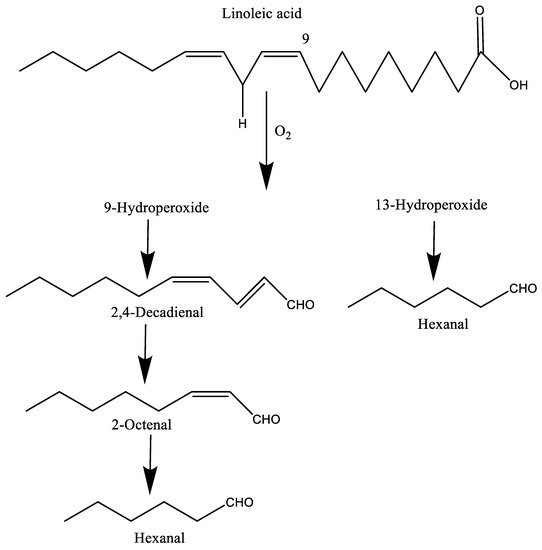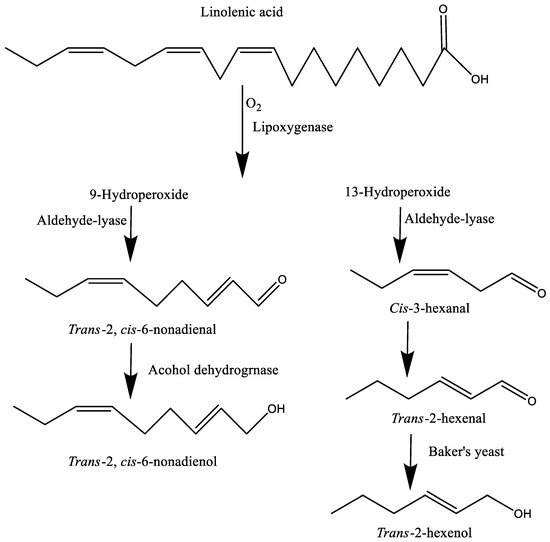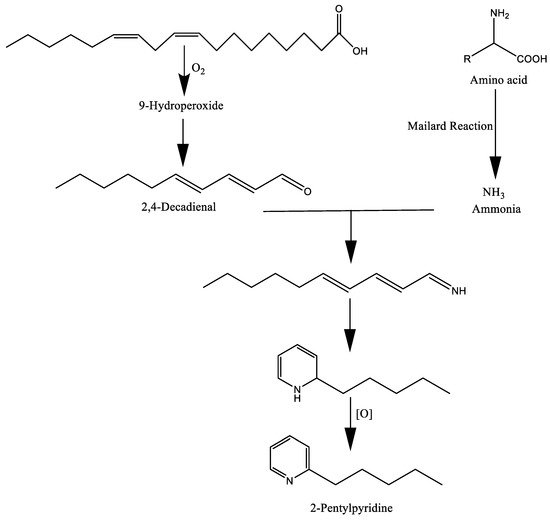Lipids in food are a source of essential fatty acids and also play a crucial role in flavor and off-flavor development. Lipids contribute to food flavor generation due to their degradation to volatile compounds during food processing, heating/cooking, and storage and/or interactions with other constituents developed from the Maillard reaction and Strecker degradation, among others. The degradation of lipids mainly occurs via autoxidation, photooxidation, and enzymatic oxidation, which produce a myriad of volatile compounds. The oxidation of unsaturated fatty acids generates hydroperoxides that then further break down to odor-active volatile secondary lipid oxidation products including aldehydes, alcohols, and ketones.
- flavor chemistry
- lipid oxidation
- Maillard reaction
1. Introduction
2. Role of Lipids Oxidation in Flavor or Off-Flavor Development
Lipids are susceptible to oxidation, which is believed to play the main non-microbial role in the quality degradation of food and food products including meat, fish, and oil-based products. Usually, off-flavors are linked very closely to lipids compared to proteins and carbohydrates. Lipid oxidation not only lessens the nutritional benefits of products due to the changes in essential fatty acids and vitamins but also negatively affects the sensory qualities such as flavor, texture, and color, which impacts on the overall consumer acceptance [6,14][6][13]. However, in some cases, lipid oxidation promotes the development of pleasant aromas, mainly during the ripening or dry-cured stages of meat products, which is one of the quality parameters of these products [15][14]. Lipid oxidation is a very complex phenomenon that undergoes a variety of reactions and produces a wide range of compounds. In a nutshell, fatty acids, mainly PUFAs, react with molecular oxygen and produce primary oxidation products (hydroperoxides) via free radical mechanisms. These compounds are highly unstable due to a weak oxygen–oxygen bond and are believed to make no contribution to odor and aroma development, but they break down rapidly and produce a wide variety of secondary constituents, which are responsible for the formation of off-flavors [16][15]. However, not all of these constituents similarly contribute to the flavor profiles, since the overall aroma perception is mainly dependent on the olfactory threshold, concentration, and type of products. Among these compounds, aldehydes seem to be the major compounds contributing to flavor development due to their low odor threshold and higher concentration. The most common aldehydes generated from lipid oxidation are n-alkanals, 4-hydroxy-2-alkenals, 2-alkenals, and malondialdehyde (MDA) [15][14]. Hence, lipid oxidation can occur in various pathways including autoxidation, photooxidation, thermal oxidation, and enzyme-catalyzed oxidation. Autoxidation is a very common lipid oxidation pathway, occurring through a continuous free-radical chain reaction. However, hydroperoxides are formed during the initiation stage of autoxidation, which is the main difference between the mechanisms of photo and enzymatic oxidation [12].2.1. Formation of Oxidation Products via Autoxidation
Autoxidation is a combination of three different phases, namely, initiation, propagation, and termination. These steps are mainly responsible for producing radicals, followed by the multiplication of reactive compounds, finally degrading or reacting with each other in order to produce non-reactive products [17][16]. Autoxidation is the spontaneous oxidation of lipids in the presence of oxygen, mainly 3O2, which can interact with radical species due to its diradical nature. However, the interaction between unsaturated fatty acids (singlet electronic state) and oxygens (triplet electronic state) is not possible because of their chemical natures. Moreover, the triplet oxygen (3O2) cannot change its state to singlet states (1O2) without external support. Therefore, an initiator is necessary to convert 3O2 into 1O2, or reactive oxygen species (ROS) such as hydroxyl radicals, hydrogen peroxide (H2O2), superoxide anions, or to generate a radical by removing an electron from the unsaturated lipids [6,15][6][14]. The activation of oxygen mainly occurs in the presence of light, temperature, or metal ions such as Fe2+ and Cu2+. At the end of the propagation stage, primary oxidation products such as lipid hydroperoxides and conjugated dienes/trienes are produced and these further break down into a series of secondary oxidation products such as aldehydes, ketones, alcohols, hydrocarbons, epoxy compounds, and volatile organic acids. Among them, some compounds are responsible for the off-flavor at very low threshold values [12]. For example, linoleic acid produces 9- and 13-hydroperoxides in the presence of oxygen, and finally generates various volatiles including 2,4-decadienal, 2-octenal, and hexanal, among others, due to the cleavage of the C–O bond by alkoxy radicals derived from these hydroperoxides (Figure 1). Similarly, oleic acid forms 8-, 9-, 10-, and 11-hydroperoxides, which leads to many secondary compounds such as pentanal, octanal, hexanal, and heptanal, among others [9,13][9][17].
2.2. Formation of Oxidation Products via Photooxidation
A possible route for lipid-derived flavor generation is lipolysis, which raises the level of free fatty acids (FFAs). The FFAs may then be oxidized via various oxidation mechanisms and produces hydroperoxides, and further decompose to a series of volatile flavor compounds [18]. Photooxidation is much faster than autoxidation, occurring in the presence of singlet oxygen (1O2), which can be generated by ultraviolet (UV) light, and/or photosensitizers including riboflavin, chlorophyll, and myoglobin. Singlet oxygen is more reactive than triplet oxygen due to its higher electrophilicity. For instance, the interaction between 1O2 and linoleic acid is about 1500 times faster than that with 3O2 [19]. The photooxidation also produces hydroperoxides in many ways, where excited triplet sensitizers (e.g., myoglobin and hemoglobin) react with molecular oxygen (3O2) and produce 1O2. Subsequently, hydroperoxides are formed upon interactions between 1O2 and double bonds of unsaturated fatty acids without forming alkyl radical [20]. Moreover, ROS such as superoxide radical anion can be formed when the sensitizer interacts with 3O2, resulting in lipid oxidation due to the abstraction of hydrogen atoms from unsaturated fatty acids. In addition, hydroxyl radicals and 1O2 produced from the interaction between superoxide radical anions and H2O2 can initiate lipid oxidation in the presence of metal ions. Furthermore, alkyl radicals produced from the reaction of fatty acids and sensitizers can react with molecular oxygen and produce peroxyl radicals, initiating oxidation via a free radical chain mechanism [15][14]. Finally, primary oxidation products such as various hydroperoxides including 9- and 10-hydroperoxides for oleic acid, 9-, 10-, 12-, 13-, 15-, and 16-hydroperoxides for linolenic acid, and 9-, 10-, 12-, and 13-hydroperoxides for linoleic acid are formed, which lead to a series of volatile compounds [6]. The formation of these hydroperoxides mainly depends on the nature of the fatty acids involved in the oxidation reaction.2.3. Formation of Oxidation Products via Enzymatic Oxidation
Lipoxygenase, the main enzyme involved in enzymatic oxidation, is found abundantly in various species of plants, animals, and fish. It is a globular protein comprising a single polypeptide chain with a molecular mass of 75–80 kDa in animals and 94–104 kDa in plants. Lipoxygenase plays an important role in the degradation of unsaturated fatty acids, resulting in flavor generation. Lipoxygenase-mediated reactions produce the aromas of freshly harvested fish through the production of both volatile alcohols and carbonyl compounds [21]. For instance, lipoxygenase in fish can react with fatty acids and produces cis-4-heptenal and 2,4,7-decatrienal isomers, which are responsible for a fishy aroma [16][15]. The rate of enzyme-catalyzed lipid oxidation mainly depends on the concentration of enzymes, which is proportional to the oxidation [15][14]. Lipoxygenase produces conjugated hydroperoxides through oxidation when the active site of the enzyme abstracts a hydrogen atom from the methylene group of fatty acids. In order to exhibit activity, the active site of the enzyme containing iron needs to be in the ferrous form [22]. In short, lipase catalyzes the first step of the lipid by hydrolysis and produces free fatty acids, followed by the production of conjugated hydroperoxy fatty acids through lipoxygenase and finally, the formation of volatiles such as carbonyl compounds. In plants, 9- and 13-hydroperoxy-octadecadienoates are transformed into reactive intermediates by hydroperoxide dehydrases, hydroperoxide lyases, epoxide hydrolases, and hydroperoxide epoxygenase [21,23][21][23]. For example, the oxidation of linolenic acid by a lipoxygenase and a subsequent lyase cleavage reaction produces trans-2, cis-6-nonadienal in cucumbers, and trans-2-hexenal in fresh tomatoes. Moreover, these carbonyl compounds may further degrade into alcohol (e.g., trans-2, cis-6-nonadienol and trans-2-hexenol), which provides a stronger aroma than the precursor of carbonyls [16][15] (Figure 2). Apart from lipoxygenase, alcohol dehydrogenase, hydroperoxide lyase, and 3Z, 2E (3cis, 2trans) enal isomerase are also involved in the biosynthetic pathway. For instance, hydroperoxy fatty acids further break down into C6 or C9 volatiles such as 3-hexenal and 3,6-nonadienal, respectively, in the presence of hydroperoxide lyase [6].
3. Flavor Chemistry: Lipid Participation in Maillard Interaction
The Maillard reaction involves a series of complex chemical reactions between the carbonyls of reducing sugars and proteins, mainly primary or secondary amines, which is responsible for the browning of food and its distinctive flavor [25]. The Maillard reaction develops a wide range of chemical constituents belonging to oxazole, thiophene, furan, thiazole, pyrrole, pyrazine, and pyridine, among others. Generally, compounds such as peptides, amino acids, thiamine, carbohydrates, nucleotides, and lipids in food promote the development of flavor. Hence, the generation of aroma volatiles is basically related to the break down and oxidation of lipids, the Maillard reaction, and the degradation of vitamins, mainly thiamine [11]. For example, the Maillard reaction between ribose and cysteine produces sulfur-containing compounds including thiophan-3-thiol and furan-3-thiol, which are responsible for the desirable meaty aroma of cooked meat [9]. In particular, the products of these reactions can act as precursors and interact with other degradation constituents of food and produce a number of long-chain heterocyclic compounds during cooking. For instance, Henderson and Nawar [26] reported the formation of 2-pentylpyridine through the interaction of lipid (linoleic acid) and Maillard reaction by-products (Figure 3). Amadori products are produced during the first stages of the reaction via glycosylamine because of the interaction between the carbonyls of reducing sugars and primary amines of amino acids, peptides, or other components. The formation of Strecker aldehydes through the degradation of amino acids and lipid oxidation is another example of developing aroma compounds [27]. These compounds react with Maillard reaction-derived carbonyls and form intermediates, which further break down into flavor compounds. Apart from amino acids, phenolic compounds may promote the generation of Strecker aldehydes. For example, amino acids and quinones originating from phenolics could produce flavor precursor volatile aldehydes through Strecker degradation [28]. The same study also reported that amino acids (e.g., phenylalanine and methionine) were capable of interacting with phenolic compounds (e.g., chlorogenic acid, caffeic acid, epicatechin, and catechin) and developing Strecker aldehydes (e.g., phenylacetaldehyde and methional) in a ferricyanide-based model system.
References
- Forss, D.A. Odor and flavor compounds from lipids. Prog. Chem. Fats Other Lipids. 1972, 13, 177–258.
- Menis-Henrique, M.E.C.; Janzantti, N.S.; Andriot, I.; Sémon, E.; Berdeaux, O.; Schlich, P.; Conti-Silva, A.C. Cheese-flavored expanded snacks with low lipid content: Oil effects on the in vitro release of butyric acid and on the duration of the dominant sensations of the products. LWT- Food Sci. Technol. 2019, 105, 30–36.
- Rota, V.; Schieberle, P. Changes in key odorants of sheep meat induced by cooking. In Food Lipids Chemistry, Flavor, and Texture; Shahidi, F., Weenen, H., Eds.; American Chemical Society: Washington, DC, USA, 2005; pp. 73–86.
- Shahidi, F. Flavour of muscle foods- an overview. In Flavor of Meat, Meat Products and Seafoods, 2nd ed.; Shahidi, F., Ed.; Blackle Academic & Professional: New York, NY, USA, 1998; pp. 1–4.
- Shahidi, F.; Hossain, A. Preservation of aquatic food using edible films and coatings containing essential oils: A review. Crit. Rev. Food Sci. Nutr. 2020, 62, 1–40.
- Shahidi, F.; Abad, A. Lipid-derived flavours and off-flavours in food. Encycl. Food Chem. 2019, 2, 182–192.
- Shahidi, F. Indicators for evaluation of lipid oxidation and off-flavor development in food. In Food Flavors: Formation, Analysis and Packaging Influences; Contis, E.T., Ho, C.-T., Mussinan, C.J., Parliment, T.H., Shahidi, F., Spanier, A.M., Eds.; Blackie Academic & Professional, Elsevier: Limnos, Greece, 1998; pp. 55–68.
- Shahidi, F.; Hossain, A. Bioactives in spices, and spice oleoresins: Phytochemicals and their beneficial effects in food preservation and health promotion. J. Food Bioact. 2018, 3, 8–75.
- Shahidi, F.; Oh, W.Y. Lipid-derived flavor and off-flavor of traditional and functional foods: An overview. J. Food Bioact. 2020, 10, 20–31.
- Kerth, C.R.; Miller, R.K. Beef flavor: A review from chemistry to consumer. J. Sci. Food Agric. 2015, 95, 2783–2798.
- Shahidi, F.; Samaranayaka, A.G.P.; Pegg, R.B. Cooking of meat, Maillard reaction and browning. In Encyclopedia of Meat Sciences, 2nd ed.; Dikeman, M., Devine, C., Eds.; Elsevier: Amsterdam, The Netherlands, 2014; pp. 391–403.
- Shahidi, F.; Zhong, Y. Measurement of antioxidant activity. J. Funct. Foods 2015, 18, 757–781.
- Hossain, A.; Dave, D.; Shahidi, F. Northern sea cucumber (Cucumaria frondosa): A potential candidate for functional food, nutraceutical, and pharmaceutical sector. Mar. Drugs 2020, 18, 274.
- Domínguez, R.; Pateiro, M.; Gagaoua, M.; Barba, F.J.; Zhang, W.; Lorenzo, J.M. A comprehensive review on lipid oxidation in meat and meat products. Antioxidants 2019, 8, 429.
- Shahidi, F. Lipids in flavor formation. In Flavor Chemistry: Industrial and Academic Research; Risch, S.J., Ho, C.-T., Eds.; American Chemical Society: Oxford, UK, 2000; pp. 24–43.
- Shahidi, F.; Zhong, Y. Lipid oxidation and improving the oxidative stability. Chem. Soc. Rev. 2010, 39, 4067–4079.
- Urbach, G.; Gordon, M.H. Flavours derived from fats. In Fats in Food Products; Moran, D.P.J., Rajah, K.K., Eds.; Springer: New York, NY, USA, 1994; pp. 347–405.
- Ke, Z.; Bai, Y.; Bai, Y.; Chu, Y.; Gu, S.; Xiang, X.; Ding, Y.; Zhou, X. Cold plasma treated air improves the characteristic flavor of Dry-cured black carp through facilitating lipid oxidation. Food Chem. 2022, 377, 1–10.
- Min, D.B.; Boff, J.M. Lipid Oxidation of Edible Oil; Marcel Dekker: New York, NY, USA, 2002; pp. 335–364.
- Choe, E.; Min, D.B. Mechanisms and factors for edible oil oxidation. Compr. Rev. Food Sci. Food Saf. 2006, 5, 169–186.
- Ho, C.-T.; Chen, Q. Lipids in food flavors. ACS Symposium Series; American Chemical Society: Washington, DC, USA, 1994; pp. 2–14.
- Ghnimi, S.; Budilarto, E.; Kamal-Eldin, A. The new paradigm for lipid oxidation and insights to microencapsulation of omega-3 fatty acids. Compr. Rev. Food Sci. Food Saf. 2017, 16, 1206–1218.
- Suzuki, T. Flavor and lipid deterioration in buckwheat flour related to lipoxygenase pathway enzymes. In Molecular Breeding and Nutritional Aspects of Buckwheat; Zhou, M., Woo, S.-H., Wieslander, G., Eds.; Academic Press: Amsterdam, The Netherlands, 2016; pp. 335–343.
- Orthoefer, T.F.; List, R.G. Dynamics of frying. In Deep Frying- Chemistry, Nutrition, and Practical Applications, 2nd ed.; Erickson, M.D., Ed.; Elsevier Inc.: New York, NY, USA, 2007; pp. 253–275.
- Hossain, A.; Dave, D.; Shahidi, F. Effect of high-pressure processing (HPP) on phenolics of North Atlantic sea cucumber (Cucumaria frondosa). J. Agric. Food Chem. 2022, 70, 3489–3501.
- Henderson, S.K.; Nawar, W.W. Thermal interaction of linoleic acid and its esters with valine. J. Am. Oil Chem. Soc. 1981, 58, 632–635.
- Kerler, J.; Winkel, C.; Davidek, D.; Blank, I. Basic chemistry and process conditions for reaction flavours with particular focus on Maillard-type reactions. In Food Flavour Technology, 2nd ed.; Taylor, A.J., Linforth, R.S.T., Eds.; Wiley-Blackwell: Oxford, UK, 2010; pp. 51–88.
- Rizzi, G.P. Formation of strecker aldehydes from polyphenol-derived quinones and α-amino acids in a nonenzymic model system. J. Agric. Food Chem. 2006, 54, 1893–1897.
- Whitfiel, B.F. Volatiles from interactions of Maillard reactions and lipids. Crit. Rev. Food Sci. Nutr. 1992, 31, 1–58.
- Troise, A.D.; Fogliano, V.; Vitaglione, P.; Berton-Carabin, C.C. Interrelated routes between the maillard reaction and lipid oxidation in emulsion systems. J. Agric. Food Chem. 2020, 68, 12107–12115.
- Farmer, L.J.; Mottram, D.S. Lipid-Maillard interactions in the formation of volatile aroma compounds. In Trends in Flavour Research; Maarse, H., vander Heij, D.G., Eds.; Elsevier: Oxford, UK, 1994; pp. 313–326.
